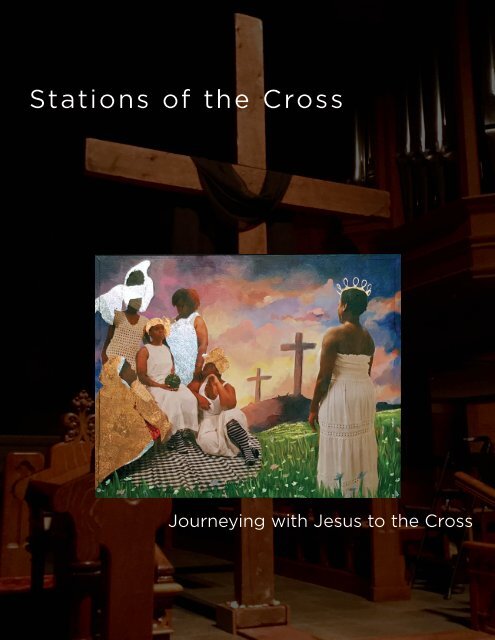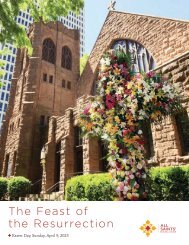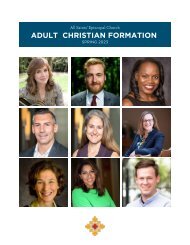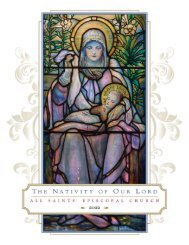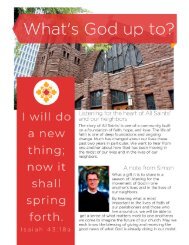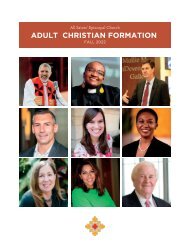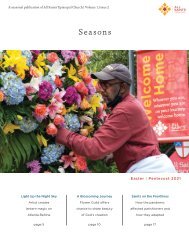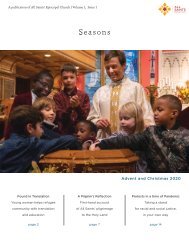Stations of the Cross 2021
During Lent, original art representing the fourteen Stations of the Cross, also known as the Way of the Cross, is installed in the All Saints’ nave by the Arts Theology Committee.
During Lent, original art representing the fourteen Stations of the Cross, also known as the Way of the Cross, is installed in the All Saints’ nave by the Arts Theology Committee.
- No tags were found...
Create successful ePaper yourself
Turn your PDF publications into a flip-book with our unique Google optimized e-Paper software.
<strong>Stations</strong> <strong>of</strong> <strong>the</strong> <strong>Cross</strong><br />
Journeying with Jesus to <strong>the</strong> <strong>Cross</strong>
During Lent,<br />
original art representing<br />
<strong>the</strong> fourteen <strong>Stations</strong> <strong>of</strong> <strong>the</strong> <strong>Cross</strong>,<br />
also known as <strong>the</strong> Way <strong>of</strong> <strong>the</strong> <strong>Cross</strong>,<br />
is installed in <strong>the</strong> All Saints’ nave<br />
by <strong>the</strong> Arts Theology Committee.<br />
The stations refer to fourteen<br />
key events at <strong>the</strong> end <strong>of</strong> Christ’s life,<br />
from <strong>the</strong> moment he is condemned<br />
to die, through his suffering,<br />
death on <strong>the</strong> cross, and burial.<br />
Historically, <strong>the</strong> Via Dolorosa<br />
in Jerusalem has been <strong>the</strong> destination<br />
<strong>of</strong> pious pilgrims since earliest<br />
Christian days. There is ample evidence<br />
<strong>of</strong> a long tradition among <strong>the</strong> faithful<br />
to create <strong>the</strong>ir own versions <strong>of</strong> <strong>the</strong> holy<br />
places <strong>of</strong> Christ’s Passion, since<br />
so few people could make <strong>the</strong> actual<br />
pilgrimage. The desire to recreate<br />
<strong>the</strong> more important shrines and key<br />
moments, to enable Christians<br />
to spiritually share in Christ’s final<br />
hours, led to <strong>the</strong> <strong>Stations</strong> <strong>of</strong> <strong>the</strong> <strong>Cross</strong><br />
as we know <strong>the</strong>m.<br />
The current form <strong>of</strong> fourteen stopping<br />
points for prayer originated in medieval<br />
Europe where artists created works<br />
depicting each key moment. The art<br />
works were <strong>the</strong>n installed along<br />
a procession route, ei<strong>the</strong>r inside <strong>the</strong><br />
church or outdoors. “Performing <strong>the</strong><br />
Devotion” meant walking <strong>the</strong> entire<br />
route, stopping to pray at each station.<br />
Station One<br />
Jesus is Condemned to Death<br />
Cover art<br />
Artist: Shanequa Gay<br />
“I am depicting an unconventional contemporary rendering <strong>of</strong> women<br />
<strong>of</strong> color in <strong>the</strong> positions <strong>of</strong> Christ, Pilate, <strong>the</strong> chief priests and elders.<br />
The surrounding women as pharisees and priests seem to be challenging<br />
Pilate on ‘her’ decision to crucify Christ. She looks on empa<strong>the</strong>tically holding<br />
a watermelon instead <strong>of</strong> a water bowl. This is a play on tropes in <strong>the</strong> black<br />
community and <strong>the</strong>ir love for watermelon, which was at one point a sacred<br />
food, full <strong>of</strong> water that cleansed <strong>the</strong> pallet and was used for water on long<br />
travels (<strong>the</strong> first water jug, if you will).<br />
The ‘Christ’ figure has a crown around her head her head, representing her<br />
as a holy person but also separate from her accusers, who adorn <strong>the</strong>mselves<br />
in silver and gold, but she is <strong>the</strong> ‘righteousness <strong>of</strong> God’ ‘holy and acceptable.’<br />
The ‘Christ’ figure stands as <strong>the</strong> third cross before <strong>the</strong> o<strong>the</strong>r two”.<br />
Shanequa Gay, an Atlanta native, received her AA in Graphic Design and Fashion<br />
Marketing from <strong>the</strong> Art Institute <strong>of</strong> Atlanta (1999), a BA in Painting<br />
from The Savannah College <strong>of</strong> Art and Design (SCAD), summa cum laude (2015),<br />
and an MFA at Georgia State University.<br />
Station Two<br />
Jesus Carries His <strong>Cross</strong><br />
Artist: Bro<strong>the</strong>r Kenneth Hosley<br />
“Prior to being asked to do this particular station, a friend <strong>of</strong> mine came<br />
to me with difficult news. He had recently been diagnosed as HIV+. When<br />
I was <strong>the</strong>n asked to create something for Christ bearing his cross, <strong>the</strong> image<br />
<strong>of</strong> “positive” in red flashed through my mind. From that, I wanted to expand<br />
and point out <strong>the</strong> modern day crosses that we carry. I wanted to point out that<br />
we carry <strong>the</strong> cross with Christ, but most importantly, that he is still carrying<br />
our own crosses with us.”<br />
Bro<strong>the</strong>r Kenneth Hosely has<br />
an MDiv from Candler School<br />
<strong>of</strong> Theology in Anglican<br />
Studies. He is a rare book and<br />
map dealer in <strong>the</strong> Atlanta area.<br />
In 2020, <strong>the</strong> Arts Theology Committee<br />
decided to begin to update and refresh<br />
some <strong>of</strong> <strong>the</strong> artworks that have been<br />
part <strong>of</strong> this collection for over 20 years.<br />
A call for entries was put out among<br />
<strong>the</strong> Atlanta art community and four new<br />
pieces were commissioned, purchased<br />
and added to <strong>the</strong> collection. Thank you<br />
to all <strong>the</strong> artists who have <strong>of</strong>fered <strong>the</strong>ir<br />
works to this exhibit over <strong>the</strong> years.
Station Three<br />
Jesus Falls for <strong>the</strong> First Time<br />
Artist: Angel Villanueva<br />
Born in California to Mexican immigrants, Angel Villanueva (b. 1977) grew up<br />
and was educated in Mexico prior to earning a dual bachelor’s degree in Art<br />
and Art History at The Claremont Colleges in Sou<strong>the</strong>rn California. He began<br />
painting at <strong>the</strong> age <strong>of</strong> 7 and was awarded his first public art commission at 17.<br />
His style is informed by classical technique, and by <strong>the</strong> extensive study <strong>of</strong> museum<br />
collections, as well as architectural and nature sites, in Europe and North America.<br />
Influenced by Magical Realism, his paintings and mural works capture conceptual,<br />
historical, and ideological convergences informed by his wide array <strong>of</strong> interests,<br />
which include history, literature, science, and psychology. His works are held<br />
in public and private collections internationally.<br />
Station Four<br />
Jesus Meets His Mo<strong>the</strong>r<br />
Artist: Ann Rhodes<br />
This image is where Jesus meets his mo<strong>the</strong>r on <strong>the</strong> Via Dolorosa. It is <strong>the</strong> most<br />
poignant image <strong>of</strong> all to me. Behind <strong>the</strong>ir confrontation in <strong>the</strong> foreground<br />
is a mo<strong>the</strong>r and child, reminding us <strong>of</strong> <strong>the</strong> relationship <strong>of</strong> Mary and Jesus.<br />
When her baby was 40 days old, Mary took him to <strong>the</strong> Temple for her own<br />
purification and to present him as her first born son. The priest, Simeon,<br />
tells Mary “Behold this child is set for <strong>the</strong> fall and rising <strong>of</strong> many in Israel…<br />
and a sword will pierce your own soul also…”<br />
Ann Rhodes is an Atlanta artist with a studio at <strong>the</strong> Tula Art Center.<br />
Her work has been shown in many galleries and hangs in private collections.<br />
Ann holds a BA in Painting from Queens College and <strong>the</strong> MA in Art History<br />
from Georgia State University.<br />
Station Five<br />
Simon Helps Jesus Carry <strong>the</strong> <strong>Cross</strong><br />
Artist: Marie Weaver<br />
“Simon stands for each <strong>of</strong> us and <strong>the</strong> opportunities we have to help o<strong>the</strong>rs,<br />
willingly or not. This painting’s composition was influenced by <strong>the</strong> decorative<br />
division <strong>of</strong> space in Medieval and Renaissance devotional art. It depicts<br />
a moment when Simon carries <strong>the</strong> bulk <strong>of</strong> <strong>the</strong> cross. However, Jesus has not<br />
let go, a reminder that Jesus never completely lets go <strong>of</strong> us.”<br />
Marie Weaver holds a BA<br />
from <strong>the</strong> University<br />
<strong>of</strong> Vermont and an MFA<br />
from Syracuse University.<br />
For many years she was<br />
a member <strong>of</strong> <strong>the</strong> faculty<br />
at <strong>the</strong> University <strong>of</strong> Alabama<br />
at Birmingham. While<br />
in Atlanta, Marie taught<br />
at <strong>the</strong> Creative Circus<br />
and <strong>the</strong> Atlanta Printmakers<br />
Studio. A native <strong>of</strong><br />
Wilmington, Delaware, she<br />
now calls Philadelphia home.
Station Six<br />
A Woman Wipes <strong>the</strong> Face <strong>of</strong> Jesus<br />
Artist: Isabelle Lamar Hines<br />
Isabelle’s paintings clearly reflect her love <strong>of</strong> color and pattern.<br />
Regardless <strong>of</strong> subject matter, her use <strong>of</strong> acrylic washes and rich<br />
opaques achieve a painterly surface as well as depth and luminosity<br />
which enhances <strong>the</strong> experience <strong>of</strong> <strong>the</strong> imagery.<br />
Isabelle Hines 1939–<strong>2021</strong>, was a successful painter in Atlanta.<br />
She studied at Mount Vernon College in Washington, D.C. and <strong>the</strong><br />
University <strong>of</strong> North Carolina at Chapel Hill. She was a passionate<br />
student <strong>of</strong> <strong>the</strong> Chatovs, Amelia James, Comer Jennings, and Ouida<br />
Canaday. Her paintings are included in many private collections.<br />
Station Seven<br />
Jesus Fall a Second Time<br />
Artist: Lilith Smith<br />
“This work was meant to evoke a monumental feeling <strong>of</strong> intensity<br />
and exhaustion. Illustrating <strong>the</strong> Christ figure’s position and proportion,<br />
my thoughts were constantly drawn back to <strong>the</strong> intensity and energy one<br />
feels from seeing a large boulder in a natural setting. I wanted to <strong>the</strong>n<br />
contrast that intensity <strong>of</strong> form with a flattening and shrinking <strong>of</strong> <strong>the</strong> landscape,<br />
drawing out <strong>the</strong> sky and land with flat, bright areas <strong>of</strong> color against <strong>the</strong> deep,<br />
expressive strokes <strong>of</strong> his form.”<br />
Lilith is from Atlanta and currently studying art at Kennesaw State University.<br />
“Woman,<br />
here is your son.”
Station Eight<br />
Jesus Meets <strong>the</strong> Women <strong>of</strong> Jerusalem<br />
Artist: David Landis<br />
“To accentuate <strong>the</strong> connections between <strong>the</strong> Women <strong>of</strong> Jerusalem, Jesus,<br />
and <strong>the</strong> <strong>Cross</strong>, I reduced <strong>the</strong> composition to <strong>the</strong> most basic elements.<br />
The women are intertwined emotionally and physically as <strong>the</strong> fabric flows<br />
and folds between <strong>the</strong>m. By using a deeply textured background, a heavy<br />
and emotional atmosphere almost obscures everything except some<br />
architectural elements, thus emphasizing <strong>the</strong> weight <strong>of</strong> <strong>the</strong> scene.”<br />
David Landis holds a BBA and MFA in sculpture from Georgia State University.<br />
He’s taught in GSU’s sculpture department and is an active member <strong>of</strong> Atlanta’s<br />
sculpture community through public panels and lectures. David’s work includes<br />
small private works as well as large-scale public commissions such as those found<br />
in Toulouse, France; Minneapolis; Albany, Georgia; Kennesaw State University;<br />
<strong>the</strong> Fulton County Government Center; <strong>the</strong> Atlanta Botanical Garden;<br />
and Atlanta’s Hartsfield-Jackson International Airport.<br />
Station Nine<br />
Jesus Falls <strong>the</strong> Third Time<br />
Artist: Ren Dillard<br />
“One <strong>of</strong> <strong>the</strong> key things I wanted to address with this commission<br />
was a different physical depiction <strong>of</strong> Jesus. As an African American<br />
who grew up in <strong>the</strong> church, I rarely saw images <strong>of</strong> Jesus that looked<br />
remotely like me. I thought it was important to tackle this issue<br />
in my painting. I also appreciated <strong>the</strong> opportunity to depict<br />
“The Third Fall”, one <strong>of</strong> <strong>the</strong> more striking visual opportunities<br />
in <strong>the</strong> narrative. As an artist, one always hopes his/her work<br />
is at <strong>the</strong> very least a conversation starter. I can only hope that this<br />
piece completes that task.”<br />
Ren is from Savannah, Georgia and a graduate <strong>of</strong> Savannah State.<br />
He is <strong>the</strong> CEO <strong>of</strong> Renswork in Atlanta.<br />
They divided my<br />
clo<strong>the</strong>s among <strong>the</strong>mselves,<br />
and for my clothing<br />
<strong>the</strong>y cast lots.”
Station Ten<br />
Jesus is Stripped <strong>of</strong> His Garments<br />
Artist: Chris Epperson<br />
“This station reflects <strong>the</strong> vulnerability <strong>of</strong> Jesus as human. I have used<br />
photography to show clothing as protection from <strong>the</strong> elements and<br />
as a shield to keep from sight <strong>the</strong> personal nature <strong>of</strong> our bodies. As Jesus<br />
is stripped <strong>of</strong> clothing, his humanity, <strong>the</strong> same humanity we all share,<br />
is laid bare for all to see.”will come.”<br />
The Rev. Chris Epperson is a former Associate Rector at All Saints’<br />
and is currently Rector <strong>of</strong> Bruton Parish in Williamsburg, Virginia.<br />
Chris has been interested in photography for many years.<br />
Station Eleven<br />
Jesus is Nailed to <strong>the</strong> <strong>Cross</strong><br />
Artist: Parlee Teague<br />
“I see <strong>the</strong> crucifixion <strong>of</strong> Jesus as a time <strong>of</strong> disorientation. Besides <strong>the</strong> pain<br />
and suffering <strong>of</strong> Jesus, <strong>the</strong> man, <strong>the</strong>re is for me <strong>the</strong> idea that reality is turned<br />
upside-down figuratively and literally. The earth and flesh became elevated.<br />
Earth becomes heaven and heaven becomes earth. Jesus hands us a new view<br />
<strong>of</strong> all eternity with this act <strong>of</strong> self-sacrifice. I used oil and graphite in depicting<br />
this station.”<br />
Parlee Teague has been an active member <strong>of</strong> All Saints’ since 1982.<br />
She has been involved in vital programs <strong>of</strong> <strong>the</strong> church including youth<br />
missions, <strong>the</strong> choir, and youth education. A self-taught painter,<br />
Parlee is also a pr<strong>of</strong>essional photographer and designer.<br />
Station Twelve<br />
Jesus Dies on <strong>the</strong> <strong>Cross</strong><br />
Artist: Isabelle Lamar Hines<br />
“This difficult subject is always a challenge. My goal was to provide an aid<br />
to meditation and prayer. The red cross speaks to <strong>the</strong> passion and suffering,<br />
<strong>the</strong> body is deathly pale. The thorns,<br />
an exaggerated instrument <strong>of</strong> torture, take<br />
on <strong>the</strong> appearance <strong>of</strong> a crown <strong>of</strong> stars.”<br />
(See Station Six for Isabelle’s biography.)<br />
in <strong>the</strong> garden<br />
<strong>the</strong>re was a new tomb<br />
in which no one
Station Thirteen<br />
Jesus is Taken Down from <strong>the</strong> <strong>Cross</strong><br />
Artist: Ann Rhodes<br />
The traditional representations <strong>of</strong> this scene always include Jesus’ mo<strong>the</strong>r<br />
Mary. They usually include John as seen here, and Mary Magdalene, who<br />
is usually shown at Jesus’ feet but is in <strong>the</strong> background here. Also traditionally<br />
present are Mary’s sisters: Mary Salome and Mary Jacobus.<br />
Station Fourteen<br />
Jesus is Laid in <strong>the</strong> Tomb<br />
(See Station Four for Ann Rhodes’ biography.)<br />
Artist: Reenie Williamson<br />
“In this work, I envisioned a burial scene with Jesus’ friends filled with great<br />
sadness after <strong>the</strong>y removed his body from <strong>the</strong> cross. I pictured his Mo<strong>the</strong>r<br />
holding him as she wept and <strong>the</strong> gentleness with which he was anointed, <strong>the</strong>n<br />
wrapped in linen cloth and carried to <strong>the</strong> tomb. Two faces in <strong>the</strong> quilt square<br />
remain blank so <strong>the</strong> viewer can imagine being a participant at <strong>the</strong> burial.”<br />
Reenie Williamson has been passionate about art since first grade.<br />
She does needlework, calligraphy, and painting and also enjoys architecture.<br />
Reenie currently resides in Mississippi.<br />
had ever been laid.
John 19:13–42<br />
Now it was <strong>the</strong> day <strong>of</strong> Preparation for <strong>the</strong> Passover; and it<br />
was about noon. He said to <strong>the</strong> Jews, “Here is your King!”<br />
They cried out, “Away with him! Away with him! Crucify<br />
him!” Pilate asked <strong>the</strong>m, “Shall I crucify your King?”<br />
The chief priests answered, “We have no king but <strong>the</strong> emperor.”<br />
Then he handed him over to <strong>the</strong>m to be crucified.<br />
So <strong>the</strong>y took Jesus; and carrying <strong>the</strong> cross by himself, he went<br />
out to what is called The Place <strong>of</strong> <strong>the</strong> Skull, which in Hebrew<br />
is called Golgotha. There <strong>the</strong>y crucified him, and with him<br />
two o<strong>the</strong>rs, one on ei<strong>the</strong>r side, with Jesus between <strong>the</strong>m.<br />
Pilate also had an inscription written and put on <strong>the</strong> cross.<br />
It read, “Jesus <strong>of</strong> Nazareth, <strong>the</strong> King <strong>of</strong> <strong>the</strong> Jews.” Many <strong>of</strong> <strong>the</strong><br />
Jews read this inscription, because <strong>the</strong> place where Jesus was<br />
crucified was near <strong>the</strong> city; and it was written in Hebrew, in<br />
<strong>Stations</strong><br />
Latin, and in Greek. Then <strong>the</strong> chief priests <strong>of</strong> <strong>the</strong> Jews said<br />
to Pilate, “Do not write, ‘The King <strong>of</strong> <strong>the</strong> Jews,’ but, ‘This man<br />
said, I am King <strong>of</strong> <strong>the</strong> Jews.’” Pilate answered, “What I have<br />
written I have written.” When <strong>the</strong> soldiers had crucified Jesus,<br />
<strong>the</strong>y took his clo<strong>the</strong>s and divided <strong>the</strong>m into four parts, one<br />
for each soldier. They also took his tunic; now <strong>the</strong> tunic was<br />
seamless, woven in one piece from <strong>the</strong> top. So <strong>the</strong>y said<br />
to one ano<strong>the</strong>r, “Let us not tear it, but cast lots for it to see<br />
who will get it.” This was to fulfill what <strong>the</strong> scripture says,<br />
“They divided my clo<strong>the</strong>s among <strong>the</strong>mselves, and for my<br />
clothing <strong>the</strong>y cast lots.”<br />
And that is what <strong>the</strong> soldiers did.<br />
Meanwhile, standing near <strong>the</strong> cross <strong>of</strong> Jesus were his mo<strong>the</strong>r,<br />
and his mo<strong>the</strong>r’s sister, Mary <strong>the</strong> wife <strong>of</strong> Clopas, and Mary<br />
Magdalene. When Jesus saw his mo<strong>the</strong>r and <strong>the</strong> disciple<br />
whom he loved standing beside her, he said to his mo<strong>the</strong>r,<br />
“Woman, here is your son.” Then he said to <strong>the</strong> disciple,<br />
“Here is your mo<strong>the</strong>r.” And from that hour <strong>the</strong> disciple took<br />
her into his own home.<br />
After this, when Jesus knew that all was now finished,<br />
he said (in order to fulfill <strong>the</strong> scripture), “I am thirsty.” A jar<br />
full <strong>of</strong> sour wine was standing <strong>the</strong>re. So <strong>the</strong>y put a sponge full<br />
<strong>of</strong> <strong>the</strong> wine on a branch <strong>of</strong> hyssop and held it to his mouth.<br />
When Jesus had received <strong>the</strong> wine, he said, “It is finished.”<br />
Then he bowed his head and gave up his spirit.<br />
Since it was <strong>the</strong> day <strong>of</strong> Preparation, <strong>the</strong> Jews did not want<br />
<strong>the</strong> bodies left on <strong>the</strong> cross during <strong>the</strong> sabbath, especially<br />
because that sabbath was a day <strong>of</strong> great solemnity. So <strong>the</strong>y<br />
asked Pilate to have <strong>the</strong> legs <strong>of</strong> <strong>the</strong> crucified men broken<br />
and <strong>the</strong> bodies removed. Then <strong>the</strong> soldiers came and broke<br />
<strong>the</strong> legs <strong>of</strong> <strong>the</strong> first and <strong>of</strong> <strong>the</strong> o<strong>the</strong>r who had been crucified<br />
with him. But when <strong>the</strong>y came to Jesus and saw that he was<br />
already dead, <strong>the</strong>y did not break his legs. Instead, one <strong>of</strong> <strong>the</strong><br />
soldiers pierced his side with a spear, and at once blood and<br />
water came out. (He who saw this has testified so that you<br />
also may believe. His testimony is true, and he knows that<br />
he tells <strong>the</strong> truth.) These things occurred so that <strong>the</strong> scripture<br />
might be fulfilled, “None <strong>of</strong> his bones shall be broken.”<br />
And again ano<strong>the</strong>r passage <strong>of</strong> scripture says, “They will look<br />
on <strong>the</strong> one whom <strong>the</strong>y have pierced.”<br />
<strong>of</strong> After <strong>the</strong>se things, Joseph <strong>of</strong> Arima<strong>the</strong>a, who was a disciple<br />
<strong>of</strong> Jesus, though a secret one because <strong>of</strong> his fear <strong>of</strong> <strong>the</strong> Jews,<br />
asked Pilate to let him take away <strong>the</strong> body <strong>of</strong> Jesus. Pilate<br />
gave him permission; so he came and removed his body.<br />
Nicodemus, who had at first come to Jesus by night, also<br />
came, bringing a mixture <strong>of</strong> myrrh and aloes, weighing about<br />
a hundred pounds. They took <strong>the</strong> body <strong>of</strong> Jesus and wrapped<br />
it with <strong>the</strong> spices in linen cloths, according to <strong>the</strong> burial<br />
<strong>Cross</strong><br />
custom <strong>of</strong> <strong>the</strong> Jews. Now <strong>the</strong>re was a garden in <strong>the</strong> place<br />
where he was crucified, and in <strong>the</strong> garden <strong>the</strong>re was a new<br />
tomb in which no one had ever been laid. And so, because<br />
it was <strong>the</strong> Jewish day <strong>of</strong> Preparation, and <strong>the</strong> tomb was nearby,<br />
<strong>the</strong>y laid Jesus <strong>the</strong>re.<br />
634 West Peachtree Street NW | Atlanta, Georgia 30308-1925<br />
telephone: 404.881.0835 | facsimile: 404.881.3796<br />
allsaintsatlanta.org


